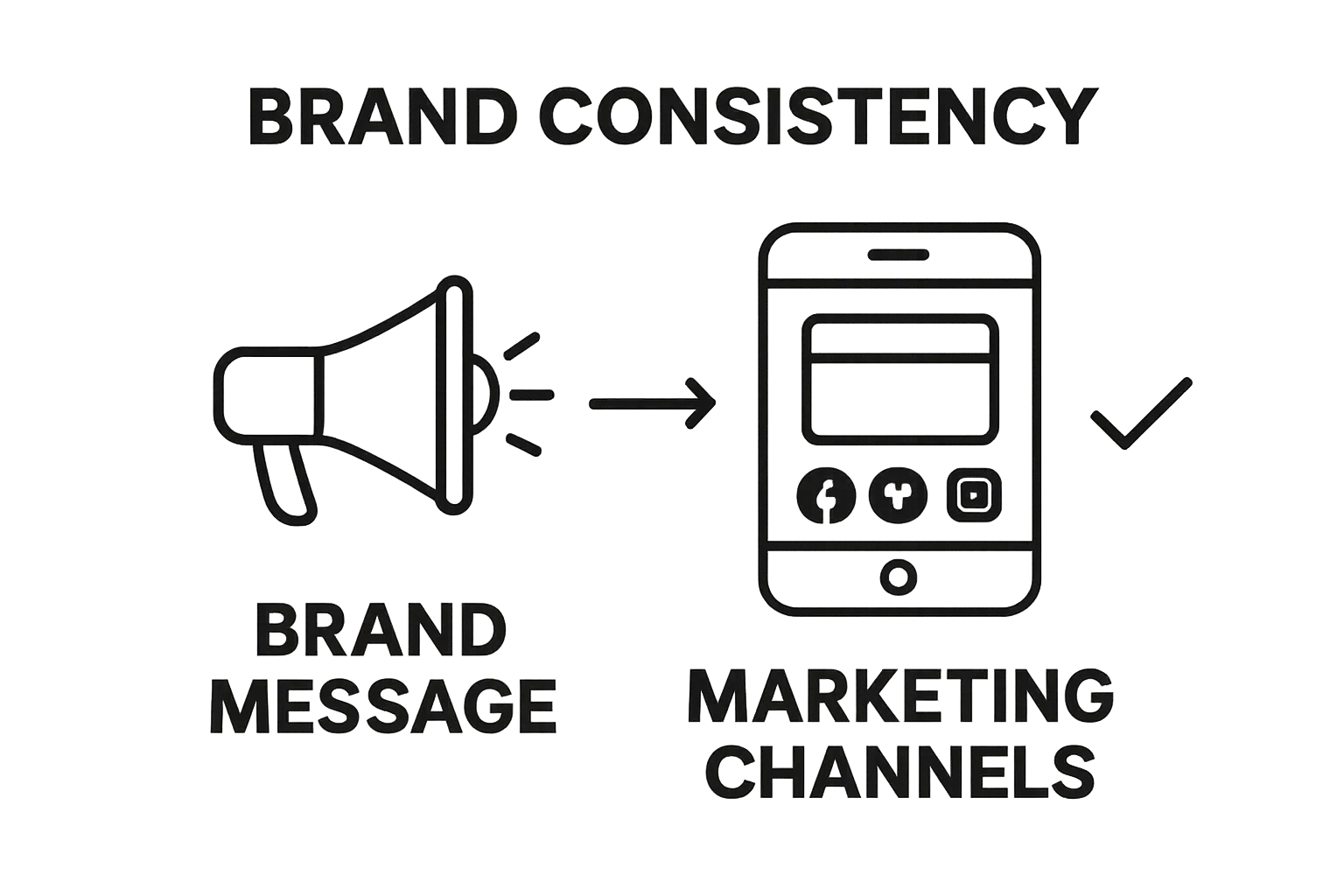Mastering Brand Positioning Strategies for Ecommerce Success
Building a strong ecommerce brand is tougher than ever with countless competitors fighting for the same attention. Online stores that invest in serious brand strategy actually see up to 23 percent higher revenue growth compared to those that ignore brand positioning. Most sellers think a few catchy ads or a pretty website will do the trick. The surprising truth is real market leaders treat their brand as an ongoing experiment, constantly analyzing, adjusting, and evolving to stay miles ahead.
Table of Contents
- Step 1: Analyze Your Current Brand Perception
- Step 2: Identify Target Audience And Their Needs
- Step 3: Define Your Unique Selling Proposition
- Step 4: Develop A Compelling Brand Message
- Step 5: Implement Positioning Across Marketing Channels
- Step 6: Evaluate And Adjust Your Brand Positioning
Quick Summary
| Key Point | Explanation |
|---|---|
| 1. Analyze Brand Perception Thoroughly | Conduct a holistic audit of brand touchpoints to assess how customers view your brand now. |
| 2. Develop Detailed Customer Personas | Create in-depth profiles that include psychological and behavioral traits beyond basic demographics. |
| 3. Clearly Define Your Unique Selling Proposition | Articulate what specifically differentiates your brand and connects with your audience’s needs. |
| 4. Craft a Compelling Brand Message | Create a powerful narrative that resonates emotionally, highlighting both emotional and practical benefits. |
| 5. Implement Consistent Multichannel Strategies | Ensure messaging is aligned across all platforms while adapting to their unique styles and audiences. |
Step 1: Analyze Your Current Brand Perception
Understanding your current brand perception is the foundational step in crafting powerful brand positioning strategies for ecommerce success. This critical initial phase allows you to establish a clear baseline of how customers currently view and interact with your brand, providing crucial insights that will shape your entire strategic approach.
Begin by conducting a comprehensive audit of your existing brand touchpoints. This means thoroughly examining your website design, social media profiles, customer interactions, product descriptions, and overall digital presence. You will want to objectively assess how your current visual and messaging elements communicate your brand’s unique value proposition. Pay special attention to consistency across different platforms and identify any potential disconnects or areas where your brand messaging might seem fragmented.
Next, gather direct feedback from your target audience through multiple research methods. Implement customer surveys that ask specific questions about brand perception, conduct one on one interviews with past customers, and analyze online reviews and social media comments. Dive deeper into understanding your brand voice to ensure your communication resonates authentically with your target market. The goal is to uncover genuine insights about how customers perceive your brand personality, values, and overall market positioning.
Qualitative and quantitative research methods will provide a comprehensive view of your current brand standing. Utilize tools like Google Analytics, social media listening platforms, and customer feedback management systems to collect data. Look for patterns in customer language, emotional responses, and perceived brand strengths or weaknesses. Track metrics such as customer sentiment, engagement rates, and brand recall to develop a nuanced understanding of your current market position.
Successful brand perception analysis requires brutal honesty and a willingness to confront potentially uncomfortable truths about your current brand image.
Below is an overview table of the six core steps to mastering brand positioning strategies for ecommerce, including the main goal and verification or outcome for each.
| Step | Main Goal | How to Verify/Key Outcome |
|---|---|---|
| Analyze Current Brand Perception | Establish how customers view your brand now | Consistent audit findings, clear baseline, documented insights |
| Identify Target Audience | Build detailed profiles with psychological and behavioral data | Personas align with actual customer data and feedback |
| Define Unique Selling Proposition (USP) | Clearly state what sets your brand apart | Customers can instantly articulate the USP |
| Develop Brand Message | Create an emotionally resonant narrative | Message resonates in testing; audience recalls key benefits |
| Implement Multichannel Positioning | Consistent messaging across all platforms | Increased engagement and brand recall across channels |
| Evaluate and Adjust Positioning | Maintain alignment with market change | KPIs improve, brand adapts while keeping core identity |
| By meticulously documenting your findings and creating a detailed report, you will establish a clear roadmap for strategic brand positioning refinement. Remember that this initial step is not about criticism but about creating an objective foundation for meaningful brand evolution. |
Step 2: Identify Target Audience and Their Needs
Identifying your target audience represents the critical bridge between understanding your brand and creating a compelling positioning strategy that resonates deeply with potential customers. This step transforms your broad market insights into precise, actionable customer understanding that will drive your entire brand strategy forward.
Start by developing comprehensive customer personas that go beyond basic demographics. Look deeper than age, gender, and income to uncover the psychological and behavioral characteristics that truly define your ideal customer. Analyze their motivations, challenges, aspirations, and purchasing behaviors. Consider conducting in depth interviews or focus groups to gain nuanced insights into their decision making processes. Learn more about audience segmentation techniques that can help you refine your understanding.
Utilize advanced data collection methods to build a multidimensional view of your target audience. Leverage tools like Google Analytics, customer surveys, social media listening platforms, and purchasing behavior analysis to create a holistic profile. Pay attention to the emotional drivers behind purchasing decisions, not just transactional data. Understand the specific pain points your product or service solves, and map out the customer journey from initial awareness to final purchase.
According to research from the National Institutes of Health, successful audience identification requires a comprehensive approach that combines quantitative data with qualitative insights. Develop a dynamic profile that can evolve as market conditions and customer preferences change. Your goal is to create a living, breathing understanding of your target audience that allows you to anticipate their needs and craft messaging that speaks directly to their unique experiences.

Verify the effectiveness of your audience identification by cross referencing your personas with actual customer interactions, sales data, and feedback. A successful target audience profile should provide clear guidance on communication strategies, product development, and brand positioning that feels authentic and compelling to your ideal customers.
Step 3: Define Your Unique Selling Proposition
Defining your Unique Selling Proposition (USP) transforms your brand from a generic marketplace participant into a standout competitor with crystal clear value. This critical step distills your brand’s most compelling attributes into a powerful, concise statement that immediately communicates why customers should choose you over every other alternative.
Craft your USP by deeply analyzing the intersection between your brand’s strongest capabilities and your target audience’s most pressing needs. Focus on solving a specific problem in a way no other competitor can. This requires ruthless honesty about what genuinely differentiates your brand. Examine your product features, customer experience, technological advantages, or brand philosophy that create exceptional value. Explore strategies for growing a distinctive brand presence that can help refine your unique positioning.
Develop multiple draft USP statements that are specific, benefit driven, and emotionally resonant. Test these drafts against key criteria: Can it be easily understood in five seconds? Does it solve a real customer problem? Is it genuinely different from competitors? The most effective USPs are not just descriptive but provocative, creating an immediate emotional connection with potential customers.
The process of defining your USP requires extensive competitive research and self reflection. Analyze your competitors thoroughly to understand their positioning, then deliberately carve out a space that feels authentically yours. Your USP should feel like a natural extension of your brand’s core identity, not an artificial marketing construct. Consider how your unique attributes solve customer pain points in ways that go beyond surface level features.
Verify the strength of your USP by testing it with actual customers and internal stakeholders. A powerful USP will generate immediate understanding, spark curiosity, and create an emotional response that differentiates your brand in a crowded marketplace. When customers can instantly articulate why your brand matters, you have successfully defined a compelling Unique Selling Proposition.
Step 4: Develop a Compelling Brand Message
Developing a compelling brand message transforms your strategic insights into a powerful narrative that resonates emotionally with your target audience. This critical step bridges the gap between your unique selling proposition and the authentic communication that will attract and retain customers.
Begin by distilling the essence of your brand into a clear, memorable core message that speaks directly to your audience’s deepest needs and aspirations. Craft a message that goes beyond product features and touches on the fundamental emotional benefits your brand delivers. This requires a deep understanding of the psychological drivers that motivate your target customers. Learn how to tell your brand story effectively to create a more impactful narrative that connects on a deeper level.
Construct your brand message with precision and authenticity. Start by drafting multiple versions that capture different aspects of your brand’s value. Each iteration should be ruthlessly evaluated against key criteria: Does it communicate your unique selling proposition? Does it create an emotional connection? Can it be understood instantly? The most powerful brand messages are simple yet profound, creating an immediate sense of understanding and alignment with your target audience.
Develop a comprehensive messaging framework that extends beyond a single statement. Create a set of core messaging pillars that can be adapted across different marketing channels while maintaining a consistent brand voice. This involves developing variations of your core message that can be tailored to specific platforms social media, email marketing, website content while preserving the fundamental emotional core of your brand communication.
Verify the effectiveness of your brand message through rigorous testing and feedback. Conduct focus groups, gather input from current customers, and test different message variations to understand which resonates most powerfully. A truly compelling brand message will create an immediate emotional response, making potential customers feel understood and excited about your brand. When your audience can instantly connect with your message and articulate why your brand matters, you have successfully developed a brand message that will drive meaningful engagement and growth.
Step 5: Implement Positioning Across Marketing Channels
Implementing your brand positioning strategy across multiple marketing channels requires a synchronized approach that ensures your core message remains consistent while being dynamically adapted to each platform’s unique characteristics. This step transforms your carefully crafted brand positioning from a theoretical concept into a living, breathing communication strategy that engages customers wherever they interact with your brand.
Develop a comprehensive channel strategy that maintains brand consistency while respecting each platform’s unique communication style. This means creating flexible messaging templates that preserve your core brand voice while allowing subtle variations that resonate with specific audience segments.
 Explore advanced digital marketing strategies to enhance your multichannel approach and maximize your brand’s reach and impact.
Explore advanced digital marketing strategies to enhance your multichannel approach and maximize your brand’s reach and impact.
Begin by mapping out a detailed content matrix that outlines how your brand message will translate across different channels. Your website, email marketing, social media platforms, paid advertising, and physical marketing materials should all communicate a unified narrative while leveraging platform specific strengths. For instance, your Instagram content might be more visually driven, while your email communications can provide deeper narrative context about your brand’s values and unique selling proposition.
Ensure technical and visual alignment by creating comprehensive brand guidelines that go beyond messaging. Develop a consistent color palette, typography, imagery style, and tone of voice document that can be easily referenced by all team members and external partners. This creates a seamless brand experience that reinforces your positioning at every customer touchpoint. Pay special attention to how your visual and verbal communication work together to communicate your brand’s core identity and differentiate you from competitors.
Verify the effectiveness of your multichannel implementation by conducting regular audits and performance reviews. Track key metrics across different platforms to understand how your positioning resonates with various audience segments. A successful implementation will show increased engagement, improved brand recall, and a growing sense of trust and connection with your target customers. When your brand message feels both consistent and naturally adapted to each communication channel, you have effectively implemented your brand positioning strategy.
Step 6: Evaluate and Adjust Your Brand Positioning
Evaluating and adjusting your brand positioning is a dynamic process that transforms your strategic approach from a static plan to a living, responsive strategy. This critical final step ensures your brand remains relevant, competitive, and aligned with evolving market conditions and customer expectations.
Establish a comprehensive monitoring system that tracks multiple performance indicators across different customer touchpoints. Implement robust analytics tools that provide deep insights into how your brand positioning resonates with your target audience. Discover strategies for building long term customer loyalty to support your ongoing brand evolution. Collect data from various sources including customer feedback, sales metrics, engagement rates, and competitive landscape analysis.
According to research from the National Institutes of Health, continuous brand strategy assessment is crucial for maintaining market relevance. Create a quarterly review process that systematically evaluates your brand positioning against key performance indicators. This should include both quantitative metrics like conversion rates and revenue growth, and qualitative assessments such as customer sentiment, brand perception surveys, and competitive positioning analysis.
Develop a flexible adjustment framework that allows for strategic pivots without losing your core brand identity. This means being prepared to refine messaging, update visual branding, or modify your unique selling proposition based on concrete evidence and emerging market trends. Pay close attention to shifts in customer behavior, technological advancements, and competitive movements that might necessitate repositioning.
The ultimate verification of successful brand positioning evaluation is a holistic improvement in brand performance. Look for increased customer loyalty, higher engagement rates, improved market share, and a more intuitive alignment between your brand messaging and customer expectations. When your brand can seamlessly adapt while maintaining its fundamental essence, you have mastered the art of strategic brand positioning in the dynamic world of ecommerce.
This checklist table summarizes key verification and evaluation steps mentioned throughout the article to ensure your brand positioning remains effective, consistent, and results-driven.
| Verification Step | Purpose | Where to Apply |
|---|---|---|
| Audit brand touchpoints | Identify inconsistencies and current perception | Website, social media, product listings |
| Gather customer feedback | Understand authentic audience insights | Surveys, interviews, reviews |
| Test messaging variants | Assess emotional resonance and clarity | Email, focus groups, online content |
| Cross-reference personas | Ensure alignment between assumption and reality | Actual customer data vs. personas |
| Monitor KPIs | Track performance against goals | Engagement, revenue, sentiment, recall |
| Quarterly review | Systematic evaluation for necessary pivots | Full brand strategy process |
Elevate Your Brand Positioning with Expert Ecommerce Retention
Struggling to turn brand positioning strategies into long-term ecommerce growth? If your journey from defining a unique selling proposition to implementing messaging across channels feels incomplete, you are not alone. Many brands expertly craft their identity yet fall short when it comes to consistent engagement, audience segmentation, and automating retention. The article’s key steps—like understanding your brand perception, optimizing your message, and evaluating effectiveness—require more than a great plan. You need an activation strategy that drives measurable results and builds real customer loyalty.

Ready to watch your email channel become a true growth engine? Partner with dedicated specialists in ecommerce retention. At Take Action, we help you translate your refined brand voice and positioning directly into conversion-focused campaign strategies and advanced email automation powered by Klaviyo. Our solutions integrate your brand vision with data-driven segmentation, personalized messaging, and seamless flows—making your positioning work for recurring revenue. Take the next step now and strengthen your market presence. Visit Take Action to unlock the full value of your newly mastered brand strategy.
Frequently Asked Questions
What is brand positioning and why is it important for ecommerce?
Brand positioning refers to the strategy of defining how your brand is perceived in the marketplace compared to competitors. It’s crucial for ecommerce success because it helps create a distinct identity that resonates with target customers, ultimately driving engagement and sales.
How can I analyze my current brand perception?
To analyze your brand perception, conduct a comprehensive audit of your brand touchpoints, gather feedback through customer surveys and interviews, and utilize analytics tools to assess customer sentiment and engagement. This will help you understand how customers currently view your brand.
What methods can I use to identify my target audience effectively?
Effective methods to identify your target audience include developing detailed customer personas, conducting in-depth interviews or focus groups, utilizing advanced data collection tools like Google Analytics, and analyzing buying behaviors to understand their motivations and pain points.
How do I create a Unique Selling Proposition (USP) for my ecommerce brand?
To create a USP, analyze your brand’s strengths in relation to your target audience’s needs, focus on specific problems your product solves, and craft a clear statement that differentiates you from competitors while creating an emotional connection with potential customers.
Recommended
- 7 Branding Mistakes to Avoid for Your Ecommerce Brand | Take Action Blog | Take Action
- 7 Essential Ecommerce Marketing Strategies for Growth | Take Action Blog | Take Action
- Understanding the Importance of Brand Voice for eCommerce | Take Action Blog | Take Action
- Master Content Calendar Creation for eCommerce Success | Take Action Blog | Take Action
- Maximize Sales with Content Marketing for Ecommerce
- Understanding the Importance of Branding Online | Ibrandmedia
